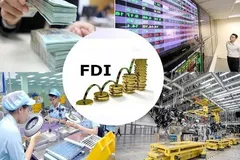
Entering 2025, the State Bank of Vietnam (SBV) continued to set a high credit growth target with a target of 16%, in order to achieve the Government's economic growth target. However, there are opinions that credit is no longer linearly related to economic growth, and credit should not be pushed at all costs.
Credit breakthrough at the end of the year
According to SBV data, as of December 31, 2024, credit had increased by 15.08%. This figure exceeded the target of 15% set at the beginning of the year. In 2024, the total outstanding credit balance of the whole system will reach VND 15.600.000 billion (at the end of 2023, it was VND 13.600.000 billion). Thus, in 2024, the banking system will inject an additional VND 2.100.000 billion into the economy.
The State Bank of Vietnam assesses that this is not a small number compared to the scale of the economy. The reason for the increase in capital demand in 2024 compared to 2023 is due to the better production and business situation of enterprises, thanks to the National Assembly and the Government having mechanisms and directions to remove difficulties; monetary and trade policies of other countries are more relaxed, reducing tensions on the impact on the Vietnamese economy and finance; open import and export create favorable conditions for the management of foreign currency policies, exchange rates, capital flows, etc.
For 2025,the State Bank initially set a credit growth target of 15% and then raised it to 16%. Therefore, at the end of December, the State Bank of Vietnam sent a document to credit institutions informing them of the principles for assigning credit growth in 2025 so that banks can proactively implement them. The level of credit growth targets assigned to banks is based on the results of the 2023 ranking score according to the provisions of Circular 52/2018/TT-NHNN (amended and supplemented), multiplied by the coefficient applied to banks.
If the target of 16% is achieved this year, it is expected that an additional VND 2.500.000 billion will be pumped into the economy, raising the total outstanding credit balance of the whole system to about VND 18.100.000 billion by the end of the year.
According to Deputy Governor of the State Bank of Vietnam Đào Minh Tú, the 16% credit growth is just the target set by the State Bank of Vietnam. Depending on the actual situation, the SBV can adjust higher or lower, because the highest goal in credit management is to stabilize the value of the currency, stabilize the exchange rate and support economic growth. The SBV is ready to open more rooms if the ability to absorb capital is better, and businesses can access capital.
GDP growth should not rely solely on credit
Deputy Governor of the SBV Đào Minh Tú also said that the banking industry also identifies its responsibility to achieve the Government's GDP growth target (GDP increases by at least 8%). Regarding GDP growth, the National Assembly sets a target of 6.5-7%, but the Government sets a minimum target of 8%.
Previously, at the National Assembly's question-and-answer session on November 11, 2024, SBV Governor Nguyễn Thị Hồng mentioned that the economy should consider other sources of capital besides banks. Because the actual demand for capital for production and business depends greatly on the credit of the banking system, the credit balance/GDP ratio of Vietnam currently accounts for more than 120% of GDP.
The Governor said that there are currently many sources of capital for enterprises and people such as self-owned capital, bank loans, capital attracting foreign direct and indirect investment, debt capital, there is now a mechanism for enterprises to borrow foreign capital, have the ability to borrow - repay themselves and have a legal framework..., enterprises and people need to consider accessing appropriate sources of capital.
Mr. Nguyễn Tú Anh, Director of the Center for Economic Information, Analysis and Forecast, Central Economic Committee emphasized that in the past, not only small and medium enterprises, but also medium enterprises have encountered many difficulties in accessing capital. Credit per capita is much higher than GDP per capita. This means there is a lack of connection between credit growth
and GDP growth. A developed economy cannot rely on banks forever but must improve the financial market comprehensively; must develop other key capital markets, including the bond and stock markets.
An economic expert commented that economic growth will have many factors affecting it, not just money pumping and increasing money supply. Looking back at 2024, at the end of each quarter, credit increased dramatically but decreased at the beginning of the next quarter. The sudden increase in growth was accompanied by a sudden increase in deposits. That raises the question of whether virtual lending to still meet credit targets is happening? If so, money is just running around in banks instead of being pumped into the economy to serve growth.
Associate Professor, Dr. Nguyễn Hữu Huân, Ho Chi Minh City University of Economics analyzed that in the current context, it is not necessary to increase credit growth at all costs to achieve high economic growth. Because data from recent years show that credit growth and economic growth are no longer a linear relationship. It is necessary to calculate that one dong of capital will create many dongs of growth, and not to calculate that capital will be pumped massively into speculative areas or lent to meet targets. If credit growth is pursued at all costs, it may lead to bad debt, it can lead to bad debt, financial bubbles, real estate bubbles, and later on, it will be more difficult to solve.




















